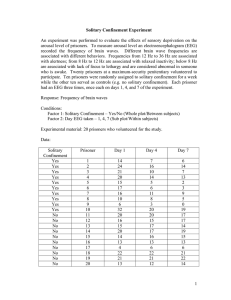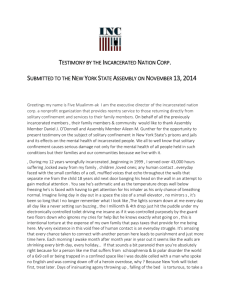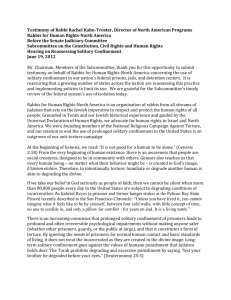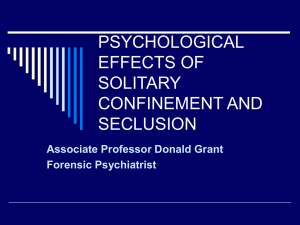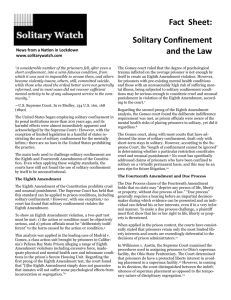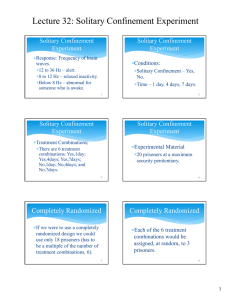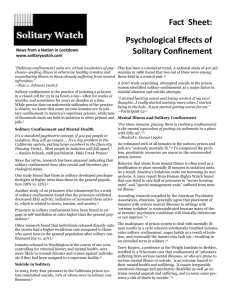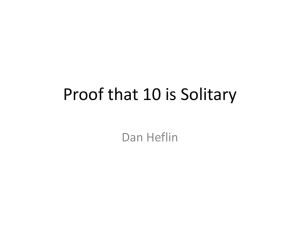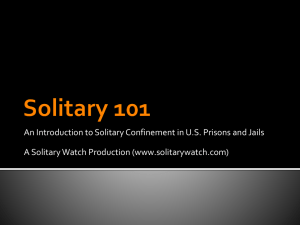lisa-guenther-vanderbilt-university
advertisement
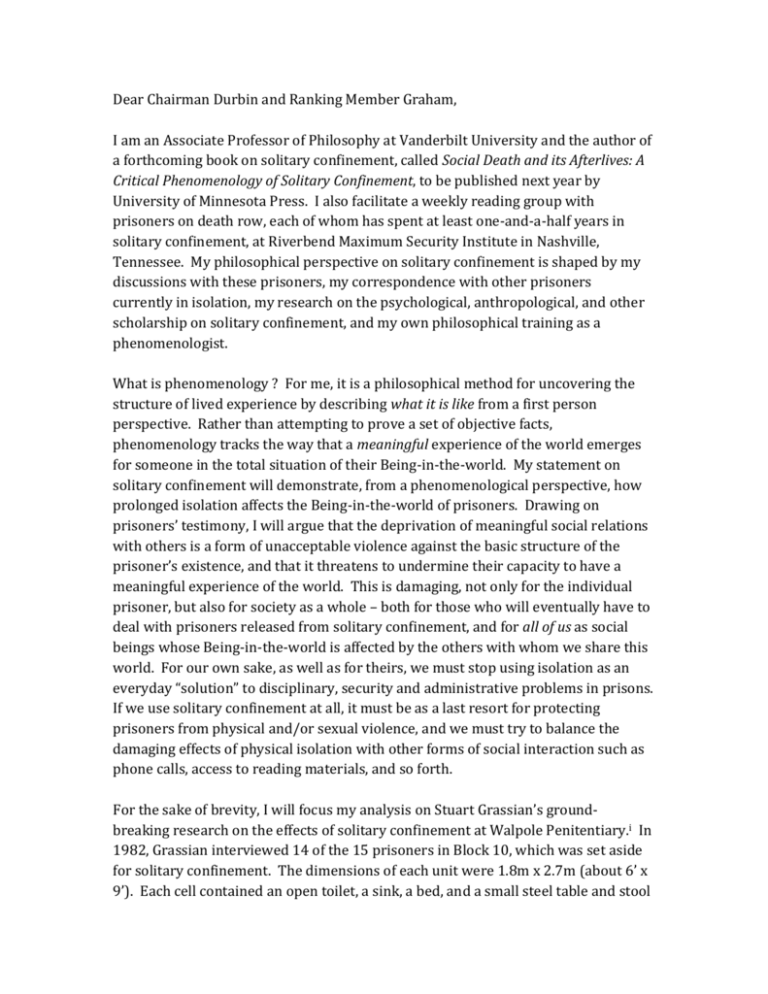
Dear Chairman Durbin and Ranking Member Graham, I am an Associate Professor of Philosophy at Vanderbilt University and the author of a forthcoming book on solitary confinement, called Social Death and its Afterlives: A Critical Phenomenology of Solitary Confinement, to be published next year by University of Minnesota Press. I also facilitate a weekly reading group with prisoners on death row, each of whom has spent at least one-and-a-half years in solitary confinement, at Riverbend Maximum Security Institute in Nashville, Tennessee. My philosophical perspective on solitary confinement is shaped by my discussions with these prisoners, my correspondence with other prisoners currently in isolation, my research on the psychological, anthropological, and other scholarship on solitary confinement, and my own philosophical training as a phenomenologist. What is phenomenology ? For me, it is a philosophical method for uncovering the structure of lived experience by describing what it is like from a first person perspective. Rather than attempting to prove a set of objective facts, phenomenology tracks the way that a meaningful experience of the world emerges for someone in the total situation of their Being-in-the-world. My statement on solitary confinement will demonstrate, from a phenomenological perspective, how prolonged isolation affects the Being-in-the-world of prisoners. Drawing on prisoners’ testimony, I will argue that the deprivation of meaningful social relations with others is a form of unacceptable violence against the basic structure of the prisoner’s existence, and that it threatens to undermine their capacity to have a meaningful experience of the world. This is damaging, not only for the individual prisoner, but also for society as a whole – both for those who will eventually have to deal with prisoners released from solitary confinement, and for all of us as social beings whose Being-in-the-world is affected by the others with whom we share this world. For our own sake, as well as for theirs, we must stop using isolation as an everyday “solution” to disciplinary, security and administrative problems in prisons. If we use solitary confinement at all, it must be as a last resort for protecting prisoners from physical and/or sexual violence, and we must try to balance the damaging effects of physical isolation with other forms of social interaction such as phone calls, access to reading materials, and so forth. For the sake of brevity, I will focus my analysis on Stuart Grassian’s groundbreaking research on the effects of solitary confinement at Walpole Penitentiary.i In 1982, Grassian interviewed 14 of the 15 prisoners in Block 10, which was set aside for solitary confinement. The dimensions of each unit were 1.8m x 2.7m (about 6’ x 9’). Each cell contained an open toilet, a sink, a bed, and a small steel table and stool fixed in place. The only light sources were a 60-watt light bulb and a small plexiglass window with no view to the outside. Prisoners were held in these cells with no access to TV, radio, or reading material other than the Bible, for a median length of two months – far shorter than the years, or even decades, currently being served by inmates in supermax prisons. Grassian found that up to 80% of prisoners suffered from perceptual, emotional, cognitive and other disturbances. These findings are consistent with psychiatric research by Craig Haney and others at institutions such as Pelican Bay State Prison.ii Grassian later coined the term SHU syndrome (named for the Special Housing Units in which the prisoners were held) to describe a cluster of symptoms including: 1) Hyperresponsivity to External Stimuli; 2) Perceptual Distortions, Illusions, and Hallucinations; 3) Panic Attacks, 4) Difficulties with Thinking, Concentration, and Memory; 5) Intrusive Obsessional Thoughts; and 6) Overt Paranoia.iii He notes that this particular configuration of symptoms is “strikingly unique” and that the perceptual disturbances in particular are “virtually found nowhere else.”iv These are the facts. But what do they mean? To answer this question, we need to listen to how the prisoners themselves describe their experience of isolation: I went to a standstill psychologically once – lapse of memory. I didn’t talk for 15 days. I couldn’t hear clearly. You can’t see – you’re blind – block everything out – disoriented, awareness is very bad. Did someone say he’s coming out of it? I think what I’m saying is true – not sure. I think I was drooling – a complete standstill. They come by [for breakfast] with four trays; the first has big pancakes – I think I’m going to get them. Then someone comes up and gives me tiny ones – they get real small, like silver dollars. I seem to see movements – real fast motions in front of me. Then seems like they’re doing things behind your back – can’t quite see them. Did someone just hit me? I dwell on it for hours. Melting, everything in the cell starts moving; everything gets darker, you feel you are losing your vision. I can’t concentrate, can’t read . . . Your mind’s narcotized . . . sometimes can’t grasp words in my mind that I know. Get stuck, have to think of another word. Memory is going. You feel you are losing something you might not get back.v Deprived of everyday encounters with other people, and cut off from an open-ended experience of the world as a place of difference and change, many inmates come unhinged from reality. Their senses seem to betray them; objects begin to move, melt or shrink of their own accord. Even the effort to reflect on their experience becomes a form of pathology, leading one prisoner to “dwell on it for hours,” while another goes into “a complete standstill.” They can’t think straight, can’t remember well, can’t focus properly, and can’t even see clearly. What is the prisoner in solitary confinement at risk of losing, to the point of not getting it back? The prisoner in a control unit may have adequate food and drink, and the conditions of their confinement may meet or exceed court-tested thresholds for humane treatment. But there is something about the exclusion of other living beings from the space that I inhabit, and the absence of even the possibility of touching or being touched by another, that threatens to unhinge the subject. We tend to view ourselves as individuals with our own separate, inherent capacity to think and perceive. At the same time, we acknowledge that humans are social animals, and that we need other people in order to live a full and happy life. But the testimony of prisoners in solitary confinement suggests that we are much more deeply connected with and dependent upon other living beings than we tend to assume. We rely on a network of others, not just to survive or to keep ourselves entertained, but also to support for our capacity to make sense of the world, to distinguish between reality and illusion, to follow a train of thought or a causal sequence, and even to tell where our own bodily existence begins and ends. Think about it: Every time I hear a sound and see another person look towards the origin of that sound, I receive an implicit confirmation that what I heard was something real, that it was not just my imagination playing tricks on me. Every time someone walks around the table rather than through it, I receive an unspoken, usually unremarkable, confirmation that the table exists, and that my own way of relating to tables is shared by others. When I don’t receive these implicit confirmations, I can usually ask someone – but for the most part, we don’t need to ask because, as Being-in-the-world, our experience is already interwoven with the experience of many other living, thinking, perceiving beings who relate to the same world from their own unique perspective. This multiplicity of perspectives is like an invisible net that supports the coherence of my own experience, even (or especially) when others challenge my interpretation of “the facts.” These facts are up for discussion in the first place because we inhabit a shared world with others who agree, at the very least, that there is something to disagree about. When we isolate a prisoner in solitary confinement, we deprive them of both the support of others, which is crucial for a coherent experience of the world, and also the critical challenge that others pose to our own interpretation of the world. Both of these are essential for a meaningful experience of things, but they are especially important for those who have broken the law, and so violated the trust of others in the community. If we truly want our prisons to rehabilitate and transform criminal offenders, then we must put them in a situation where they have a chance and an obligation to explain themselves to others, to repair damaged networks of mutual support, and to lend their own unique perspective to creating meaning in the world. When we lock someone in a control unit for breaking prison rules, for being labeled as a gang member, or even for attempting to harm themselves or others, then we are punishing them in a way that blocks the very transformation that we expect of them. It may sound like I am proposing a “soft” policy that may work for non-violent offenders, but not for murderers, rapists, and other violent criminals. I have seen first-hand in my weekly discussion group with men on death row that this is not the case. These men did not get to the point of working together to create positive change in their unit, in their lives, and in the wider community, by being isolated from one another in solitary confinement; they got there thanks to a levels system that allows even prisoners slated for execution to work their way out of isolation towards what they like to call a “therapeutic community.” We ask too little of prisoners when we lock them into control units where they are neither allowed nor obliged to create and sustain meaningful, supportive relations with others. For the sake of justice, not only for them but for ourselves, we must put an end to the over-use of solitary confinement in this country, and we must begin the difficult but mutually-rewarding work of bringing the tens of thousands of currently-isolated prisoners back into the world. Sincerely, Dr. Lisa Guenther i Stuart Grassian, “Psychopathological effects of solitary confinement,” American Journal of Psychiatry 140:11 (1983), 1450-1454. ii See, for example, Craig Haney, “Mental Health Issues in Long-Term Solitary and "Supermax" Confinement,” Crime Delinquency 49:1 (2003), 124-156; Craig Haney and Mona Lynch, “Regulating Prisons of the Future: A Psychological Analysis of Supermax and Solitary Confinement,” New York University School of Law Review of Law and Social Change. 23:4 (1997), 477-570. iii Stuart Grassian, “Psychiatric Effects of Solitary Confinement,” Journal of Law & Policy 22 (2006), 335-6. iv Ibid., 337. v Grassian 1983, 1452-3.
